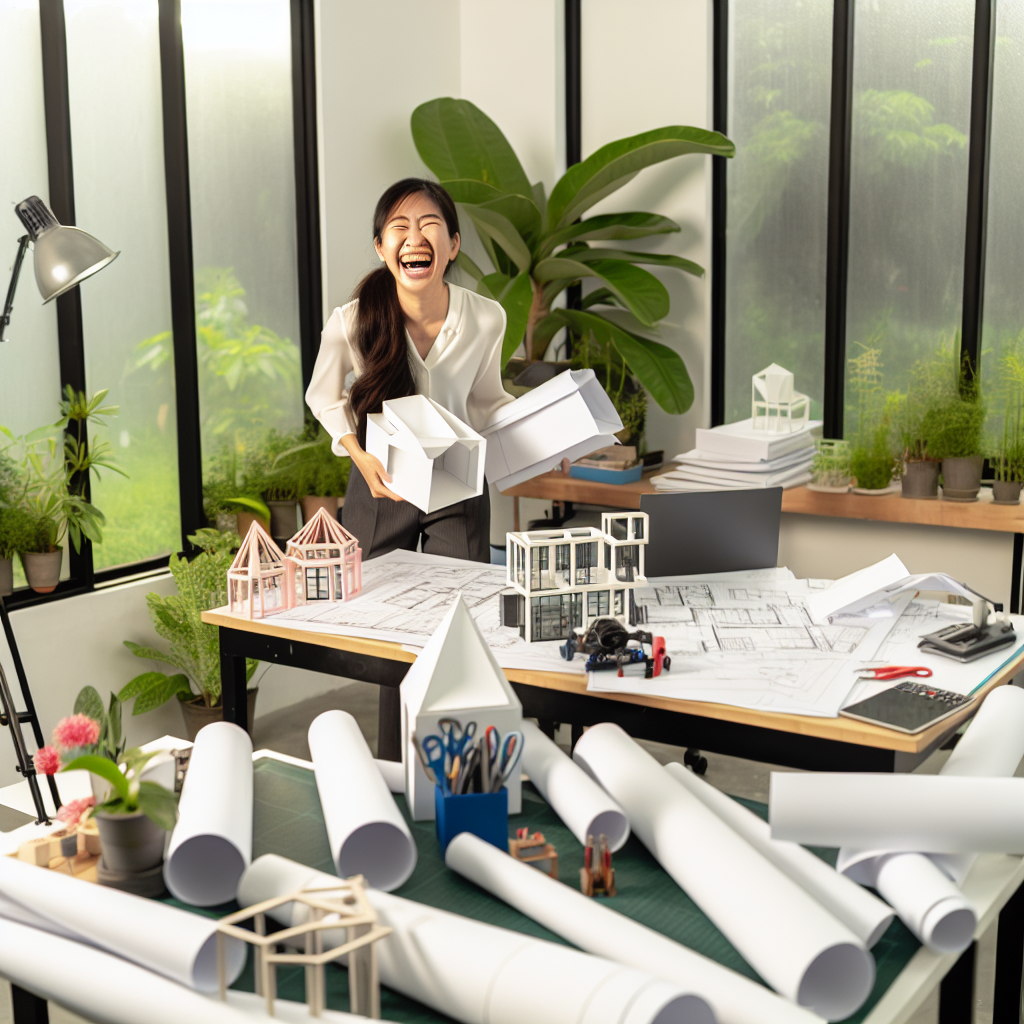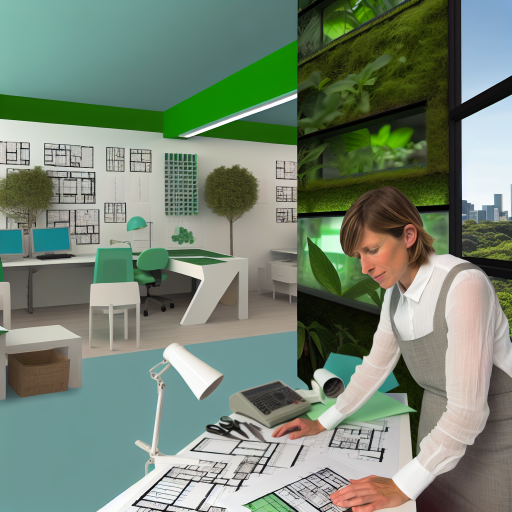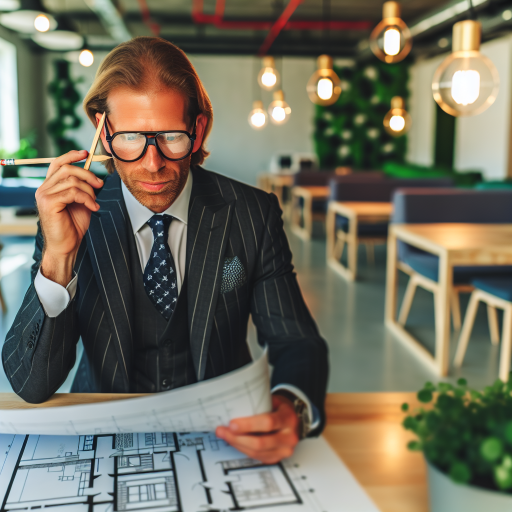Introduction to Sustainability in Office Design
Sustainability has become a critical element in modern office space design.
More businesses recognize the need to integrate sustainable practices.
These practices focus on reducing environmental impact and enhancing workplace wellbeing.
Importance of Sustainable Design
Sustainable design minimizes resource consumption and waste production.
It helps companies reduce their carbon footprints significantly.
Moreover, such design contributes to employee satisfaction and productivity.
Key Elements of Sustainable Office Design
Incorporating natural light can improve energy efficiency in office spaces.
Green materials enhance indoor air quality and reduce environmental impact.
Furthermore, smart technologies optimize resource usage effectively.
Natural Light
Access to natural light promotes a healthier work environment.
It decreases reliance on artificial lighting, thus saving energy.
Eco-Friendly Materials
Using recycled and sustainably sourced materials benefits the environment.
These materials typically have a lower environmental impact during production.
Smart Technology
Implementing smart systems can automate lighting and heating controls.
This technology not only saves energy but also enhances the user experience.
Long-term Benefits of Sustainable Office Design
Investing in sustainable office design yields long-term financial advantages.
It can lead to significant cost savings on energy and maintenance.
Additionally, it enhances a company’s public image and attracts talent.
Historical Context of Office Space Design and Sustainability
Evolution of Office Space Design
Office space design has changed dramatically over the decades.
Initially, offices emphasized rigidity and hierarchy.
Cubicles became prevalent in the 1960s and 70s.
This promoted privacy but reduced collaboration.
By the late 20th century, open-plan offices emerged.
These designs aimed to enhance communication among employees.
However, they also led to noise and distractions.
Consequently, designers sought better balance in office layouts.
The Emergence of Sustainability in Design
In the late 20th century, environmental concerns grew significantly.
Corporate responsibility became a hot topic worldwide.
Designers began exploring sustainable office solutions.
They focused on reducing energy consumption and waste.
Consequently, green building certifications emerged.
LEED became one of the most recognized standards.
Sustainable materials and energy-efficient systems gained popularity.
Integration of Sustainability in Modern Office Designs
Today, sustainability is a key factor in office design.
Firms strive for energy-efficient practices and renewable resources.
Biophilic design has also gained traction in recent years.
This approach incorporates natural elements into office environments.
Plants, natural light, and fresh air improve employee well-being.
Moreover, remote work trends have influenced office layouts.
Companies now design flexible spaces to accommodate varying needs.
Benefits of Sustainable Office Design
Sustainable office design promotes environmental stewardship.
It also enhances employee productivity and satisfaction.
Reduced operational costs benefit businesses financially.
Furthermore, a commitment to sustainability improves brand image.
Clients and consumers increasingly favor environmentally friendly companies.
Key Principles of Sustainable Design in Modern Offices
Energy Efficiency
Energy efficiency stands at the forefront of sustainable office design.
Installing LED lighting significantly reduces energy consumption.
Incorporating smart technology controls energy use based on occupancy.
Moreover, selecting energy-efficient appliances is crucial.
Organizations should also consider the orientation of their buildings.
Natural light reduces reliance on artificial lighting.
Use of Sustainable Materials
Choosing sustainable materials is vital in modern office design.
Reclaimed wood and bamboo offer beautiful, eco-friendly options.
Moreover, non-toxic paints contribute to healthier indoor air quality.
Utilizing recycled metals and plastics helps reduce waste.
Additionally, using sustainable furniture supports environmental goals.
Each material choice reflects a commitment to sustainability.
Water Conservation
Water conservation plays a significant role in sustainable design.
Implementing low-flow fixtures drastically reduces water usage.
Rainwater harvesting systems can provide an alternative water source.
Furthermore, landscaping with native plants minimizes irrigation needs.
Educating employees about water conservation practices is essential.
These strategies enhance the office’s overall sustainability profile.
Indoor Environmental Quality
Enhancing indoor environmental quality is critical for occupant well-being.
Effective ventilation systems ensure fresh air circulation.
Incorporating plants improves air quality and adds aesthetic value.
Moreover, choosing non-toxic materials reduces indoor pollution.
Regular maintenance of HVAC systems promotes a healthier environment.
Creating spaces for relaxation contributes to overall employee health.
Community Engagement
Community engagement strengthens a company’s commitment to sustainability.
Involving employees in green initiatives fosters a culture of responsibility.
Collaborating with local businesses can enhance sustainability efforts.
Additionally, participating in community clean-up days promotes awareness.
Sharing sustainability goals with stakeholders builds goodwill.
Finally, transparency in practices enhances brand reputation.
You Might Also Like: How To Increase The Value Of Your Industrial Real Estate Portfolio
Materials and Resources: Choosing Sustainable Options for Construction
Importance of Sustainable Materials
Sustainable materials minimize environmental impact during construction.
These materials reduce waste and resource depletion.
Furthermore, they contribute to healthier office environments.
Types of Sustainable Materials
Recycled materials are an excellent choice for office construction.
They often possess similar properties to virgin materials.
Bamboo is another sustainable option due to its rapid growth.
Additionally, reclaimed wood adds character while promoting recycling.
Non-toxic paints and finishes enhance indoor air quality.
Benefits of Sustainable Material Choices
Using sustainable materials enhances a company’s reputation.
It attracts environmentally conscious clients and employees.
Moreover, sustainable choices can lower operational costs over time.
Energy-efficient materials contribute to reduced energy consumption.
Certifications to Consider
Look for materials with environmental certifications.
LEED certification indicates strong sustainability practices.
FSC certification ensures responsible forestry management.
By choosing certified materials, companies demonstrate commitment to sustainability.
Strategies for Implementation
Start by assessing the current material usage in your projects.
Identify areas for improvement and set measurable goals.
Engage with suppliers who provide sustainable options.
Train staff on the importance of sustainable material choices.
Finally, regularly review and update material policies as needed.
Discover More: How to Evaluate Commercial Real Estate for Long-Term Growth Potential
Energy Efficiency: Implementing Green Technologies
The Importance of Energy Efficiency
Energy efficiency plays a crucial role in sustainable office space design.
It helps reduce operational costs for businesses.
Moreover, it contributes to lowering environmental impact.
By adopting efficient practices, companies enhance their brand image as eco-friendly.
Integrating Green Technologies
Implementing green technologies transforms energy consumption patterns.
Advanced lighting systems can significantly cut electricity usage.
For instance, LED lights consume less power than traditional options.
Smart thermostats optimize heating and cooling based on occupancy.
Consequently, these technologies improve overall comfort in the workplace.
Examples of Effective Green Technologies
- Solar panels harness renewable energy from the sun.
- Energy-efficient HVAC systems maintain optimal indoor climate.
- Water-saving fixtures reduce consumption without sacrificing performance.
Incorporating these technologies is essential for modern offices.
Benefits of a Sustainable Office
Aside from cost savings, sustainable offices attract eco-conscious tenants.
They offer healthier environments that enhance employee productivity.
Employees value companies committed to sustainability initiatives.
This commitment fosters loyalty and enhances workplace morale.
In turn, this leads to a more motivated workforce.
Challenges in Implementation
Transitioning to energy-efficient technologies poses challenges.
Initial costs for installation can be a significant hurdle.
However, these investments yield long-term savings and benefits.
Additionally, staff may need training on new systems.
Yet, the transition can result in greater overall efficiency.
See Related Content: The Pros And Cons Of Converting Industrial Space Into Mixed-Use
Indoor Environmental Quality: Enhancing Employee Health and Well-being
Importance of Indoor Air Quality
Indoor air quality significantly impacts employee health.
Poor air quality can lead to respiratory issues and fatigue.
On the other hand, clean air improves concentration and productivity.
Implementing ventilation systems helps to enhance air quality.
Naturally ventilated spaces can also create a healthier environment.
Lighting and Employee Mood
Lighting plays a pivotal role in office design.
Natural light positively affects employee mood and performance.
Incorporating large windows allows for better light flow.
Additionally, adjustable lighting can accommodate different tasks.
Proper lighting helps reduce eye strain and fatigue.
Acoustics and Privacy
Office acoustics influence overall comfort and productivity.
Noisy environments can hinder focus and concentration.
Using sound-absorbing materials reduces noise pollution.
Designing collaborative spaces with privacy in mind is essential.
Quiet zones encourage deep work and creativity.
Biophilic Design Elements
Bringing nature indoors enhances workplace well-being.
Plants purify the air and improve aesthetics.
Natural elements promote relaxation and reduce stress levels.
Incorporating green walls or indoor gardens can boost morale.
Furthermore, outdoor views connect employees to their environment.
Flexibility in Workspace Design
Flexible workspaces cater to diverse employee needs.
Adjustable furniture fosters comfort and productivity.
Create spaces that accommodate varied working styles.
Individual workstations can blend with collaborative areas.
This adaptability enhances employee satisfaction and productivity.
Find Out More: How Retail Spaces Are Evolving to Meet Changing Consumer Demands

The Economic Impact of Sustainable Office Designs
Cost Savings through Efficiency
Sustainable office designs lower operational costs.
Energy-efficient systems reduce utility bills significantly.
Moreover, utilizing renewable energy sources cuts ongoing expenses.
For instance, companies like GreenWorks have reported savings of up to 30% in energy costs.
Attracting Investment
Investors are increasingly drawn to sustainable businesses.
Eco-friendly offices enhance a company’s reputation.
As a result, businesses attract a broader range of investors.
Firms demonstrating commitment to sustainability, like EcoTech, see higher valuations.
Boosting Employee Productivity
Sustainable designs create healthier work environments.
Natural light and good air quality improve employee well-being.
Employees in green offices are more productive and engaged.
For example, studies indicate that workers in eco-friendly spaces report a 15% increase in productivity.
Long-Term Value and Resilience
Investing in sustainable office designs increases property value.
These properties tend to have lower vacancy rates over time.
Furthermore, sustainable buildings often comply with future regulations.
This compliance means less risk of costly renovations later.
Businesses like Urban Green have successfully enhanced their asset value through sustainable initiatives.
Supporting Local Economies
Sustainable office designs often utilize local materials and labor.
This approach fosters economic growth in surrounding communities.
Additionally, businesses engaged in sustainability support local suppliers.
They help create a circular economy that benefits all stakeholders.
Long-Term Benefits of Sustainability
The economic impact of sustainable office designs is profound.
Cost savings, increased investment, and better productivity make a strong case.
Embracing sustainability leads to long-term benefits for businesses and the community.
Regulatory Frameworks and Certifications for Sustainable Buildings
Importance of Regulatory Frameworks
Regulatory frameworks play a crucial role in promoting sustainability.
They establish guidelines that buildings must follow to minimize their environmental impact.
Compliance with these regulations ensures safer and greener construction practices.
Moreover, these frameworks foster accountability among builders and developers.
Key Regulations in Sustainable Building
Different regions have specific regulations targeting sustainable construction.
The International Green Construction Code (IgCC) supports sustainable building practices in the U.S.
In Europe, the Energy Performance of Buildings Directive (EPBD) focuses on energy efficiency.
Additionally, countries often adapt their building codes to include sustainable criteria.
Leading Certifications for Sustainability
Various certification systems recognize sustainable building practices worldwide.
LEED, developed by the U.S. Green Building Council, is widely recognized.
It evaluates buildings based on energy savings, water efficiency, and indoor air quality.
BREEAM, originating in the UK, assesses the environmental performance of buildings.
These certifications provide developers with frameworks to improve sustainability.
Benefits of Achieving Certifications
Obtaining sustainability certifications brings significant advantages.
It enhances a building’s marketability and can attract environmentally conscious tenants.
Furthermore, certified buildings often enjoy reduced operating costs over time.
Additionally, some certifications may lead to tax incentives or funding opportunities.
Challenges in Implementing Regulations
While regulations promote sustainability, challenges persist in their implementation.
Cost factors often hinder compliance for smaller businesses and projects.
Lack of awareness and knowledge can also impede adherence to sustainable practices.
More importantly, varying regulations can create confusion in international projects.
Future of Sustainable Building Regulations
A shift towards stricter regulations is evident in many regions worldwide.
Governments are increasingly prioritizing green building initiatives.
Future regulations will likely focus on carbon neutrality and resource conservation.
Moreover, emerging technologies will enhance compliance strategies significantly.
This evolution will contribute to a more sustainable built environment for future generations.
Case Studies of Successful Sustainable Office Spaces
Eco-Friendly Corporate Headquarters
GreenTech Innovations built its headquarters with sustainability as a priority.
The design features extensive use of recycled materials.
Solar panels provide a significant portion of the building’s energy needs.
Natural ventilation systems reduce reliance on air conditioning.
Additionally, landscaped green roofs improve insulation and promote biodiversity.
Flexible Workspaces with a Green Focus
Urban Dynamics implemented a flexible workspace strategy to enhance collaboration.
They prioritized natural lighting and open layouts to boost employee well-being.
The use of low-VOC materials contributes to better indoor air quality.
Moreover, the office includes a rainwater harvesting system for irrigation.
Community-Centric Eco Offices
Community Builders Inc. crafted a space that fosters local engagement.
The building incorporates local materials to support nearby businesses.
Its design encourages walking and cycling through accessible paths.
Moreover, the office hosts regular community events to promote sustainability.
Thus, it strengthens the bond between the organization and the locality.
Adaptive Reuse in Urban Environments
Old Mill Works transformed a disused mill into a modern office space.
This project preserved historical architecture while upgrading infrastructure.
Sustainable practices included energy-efficient lighting and landscaping.
Moreover, the office integrates technology to monitor energy consumption.
Employees enjoy a unique workspace that respects local heritage.
Future Trends in Sustainable Office Design
Integration of Smart Technology
Smart technology increasingly integrates into sustainable office spaces.
IoT devices help monitor energy usage in real-time.
These devices can optimize heating, cooling, and lighting efficiency.
Consequently, businesses reduce their carbon footprint effectively.
Emphasis on Biophilic Design
Biophilic design is gaining traction in modern workplaces.
This approach incorporates natural elements into workspace design.
Natural light, plants, and water features enhance employee well-being.
Additionally, it fosters creativity and productivity among staff.
Modular and Flexibility in Design
Flexibility is a key trend in sustainable office design.
Companies now prefer modular furniture that adapts to changing needs.
Alterable spaces accommodate collaboration or quiet work time.
As a result, businesses can maximize their real estate investments.
Use of Sustainable Materials
The use of sustainable materials is on the rise.
Materials such as bamboo, reclaimed wood, and recycled metals are now common.
These choices reduce the environmental impact of building projects.
Furthermore, they promote healthier indoor air quality.
Community-Centric Approaches
Modern office spaces prioritize community and collaboration.
Shared workspaces encourage innovation and social interaction.
These designs often feature communal areas for informal gatherings.
By fostering community, businesses enhance their employee satisfaction.
Green Certifications and Standards
Organizations increasingly seek green certifications for their buildings.
Certifications like LEED and BREEAM evaluate sustainability efforts.
These standards encourage companies to adopt environmentally friendly practices.
With certifications, businesses enhance their brand credibility.
Additional Resources
2025 commercial real estate outlook | Deloitte Insights
Energy Efficiency in Sustainable Buildings: A Systematic Review …




